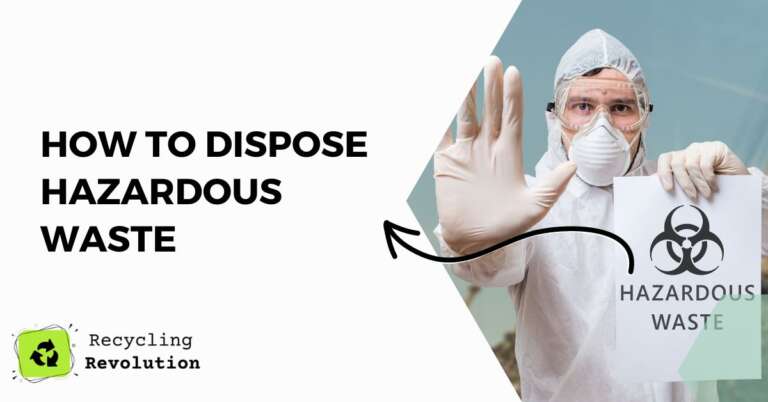When you think of hazardous waste, your mind might instantly jump to images of toxic sludge or radioactive materials. But what exactly constitutes hazardous waste, and why is it so important to dispose of it properly?
In this article, we’ll guide you through the intricacies of hazardous waste disposal, ensuring that you’re well-equipped to handle these materials safely and responsibly.
How to Identify Hazardous Waste
First things first: what is hazardous waste? Simply put, hazardous waste is any waste material that poses a threat to public health, the environment, or both. Identifying hazardous waste can be a bit trickier, but it generally falls into one or more of these categories:
- Ignitable (easily catches fire)
- Corrosive (can dissolve other materials)
- Reactive (may explode or release toxic fumes)
- Toxic (harmful or fatal when ingested or absorbed)
Knowing how to identify hazardous waste is crucial to ensuring its safe and responsible disposal. Familiarize yourself with the various types and their unique dangers so you can protect both yourself and the environment.
Safe Storage of Hazardous Waste
Before you dispose of hazardous waste, it’s essential to store it safely. This will not only protect you and your loved ones from potential harm, but it will also help prevent environmental contamination. Here’s how to store hazardous waste properly:
- Keep it in its original container. This helps you easily identify the waste and prevents accidental mixing of incompatible substances.
- Seal containers tightly. Prevent leaks and spills by ensuring all containers are securely closed.
- Store in a cool, dry place. Avoid extreme temperatures and direct sunlight, as these can cause certain hazardous materials to become more dangerous.
- Keep it away from children and pets. Store hazardous waste in a locked cabinet or other secure location.
Common storage mistakes to avoid include mixing different types of waste, using damaged containers, and storing waste in unsuitable locations like food storage areas.
Methods of Hazardous Waste Disposal
Now that you know how to identify and store hazardous waste, let’s explore the various disposal methods available. Here are the most common options and best practices for each:
1. Recycling: Many hazardous waste materials can be recycled into new products. Examples include batteries, electronics, and fluorescent bulbs. Always check your local recycling guidelines and drop-off locations for specific instructions.
2. Incineration: This method involves burning hazardous waste at high temperatures, destroying harmful substances and converting them into ash, water vapor, and carbon dioxide. Incineration is typically reserved for medical and industrial waste.
3. Landfills: Specially designed hazardous waste landfills are equipped with liners and monitoring systems to prevent contamination of soil and groundwater. However, not all hazardous waste is suitable for landfill disposal.
4. Chemical treatment: Some hazardous waste can be neutralized or made less harmful through chemical processes. This is often used for laboratory chemicals and industrial waste.
When choosing the right disposal method, always consult local regulations and follow best practices to ensure the safety of yourself and the environment.
Legal and Environmental Regulations
Hazardous waste disposal is subject to strict laws and regulations, and for good reason. Improper disposal can have serious consequences for human health and the environment. Penalties for noncompliance may include fines, imprisonment, or both.
It’s essential to familiarize yourself with the applicable laws and regulations in your area to ensure you’re disposing of hazardous waste legally and responsibly.
Tips for Hazardous Waste Disposal at Home
Many common household items qualify as hazardous waste, including paint, pesticides, and cleaning supplies. Here are some best practices for disposing of these materials:
- Read labels carefully. Manufacturers often provide instructions for proper disposal on product packaging. Follow these guidelines to ensure safety.
- Don’t pour hazardous waste down the drain or toilet. This can contaminate water supplies and harm local ecosystems.
- Use a hazardous waste collection facility. Many communities offer designated drop-off locations for household hazardous waste. Check your local resources to find one near you.
- Participate in community collection events. Some areas host periodic hazardous waste collection events, providing a convenient opportunity to dispose of unwanted materials.
- Reduce your use of hazardous products. Seek out eco-friendly alternatives whenever possible, and purchase only the amount you need to minimize waste.
Conclusion
Hazardous waste disposal is a critical component of responsible waste management. By understanding how to identify, store, and dispose of these materials, you’re taking an essential step in protecting public health and the environment. Remember to always follow local regulations and best practices, and encourage others to do the same. Together, we can make a positive impact on our planet and ensure a safer, cleaner future for generations to come.
FAQs
What are the most common methods of disposing hazardous waste?
The most common methods of disposing hazardous waste include recycling, incineration, landfills, and chemical treatment. The appropriate method depends on the type of waste and local regulations.
How do you handle extremely hazardous waste?
Extremely hazardous waste should be handled with great care. Consult experts, follow guidelines provided by regulatory agencies, and use specialized facilities for proper disposal. Never attempt to dispose of highly hazardous materials without professional guidance.
What are the five ways in which hazardous waste can be disposed?
Hazardous waste can be disposed of through recycling, incineration, landfills, chemical treatment, and physical treatment (e.g., shredding, compaction). The appropriate method depends on the type of waste and local regulations.

